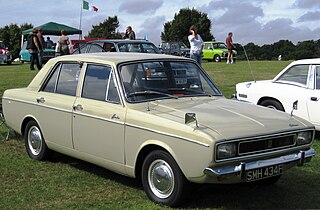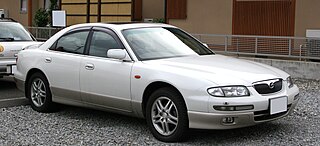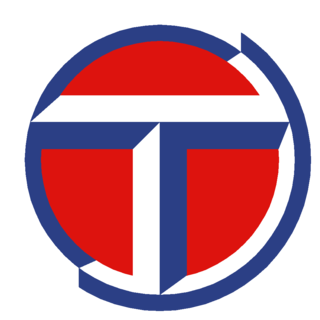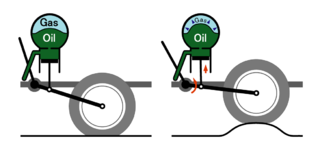A.E.R. was a French automobile manufacturer and one-time subsidiary of B.N.C.; the marque offered two cars patterned on American models. One was a sidevalve 1991cc six-cylinder with CIME engine; the other used a Lycoming side valve straight-eight of 4241 cc and Delaunay-Belleville chassis. Unusually, suspension was by a pneumatic device which soon proved unreliable. Production ceased after one year of manufacture (1930), but the cars were later reissued under the name Aigle, in models using conventional suspension.

Land Rover is a British brand of predominantly four-wheel drive, off-road capable vehicles, owned by multinational car manufacturer Jaguar Land Rover (JLR), since 2008 a subsidiary of India's Tata Motors. JLR currently builds Land Rovers in Brazil, China, India, Slovakia, and the United Kingdom. The Land Rover name was created in 1948 by the Rover Company for a utilitarian 4WD off-road vehicle; currently, the Land Rover range consists solely of upmarket and luxury sport utility vehicles.

Citroën is a French automobile brand. The "Automobiles Citroën" manufacturing company was founded in March 1919 by André Citroën. Citroën has been owned by Stellantis since 2021 and previously was part of the PSA Group after Peugeot acquired 89.95% share in 1976. Citroën's head office is located in the Stellantis Poissy Plant in Saint-Ouen-sur-Seine since 2021 and its offices studies and research in Vélizy-Villacoublay, Poissy (CEMR), Carrières-sous-Poissy and Sochaux-Montbéliard.

The Cadillac Motor Car Division is a division of the American automobile manufacturer General Motors (GM) that designs and builds luxury vehicles. Its major markets are the United States, Canada and China. Cadillac models are distributed in 34 additional markets worldwide. Historically, Cadillac automobiles were at the top of the luxury field within the United States, but have been outsold by European luxury brands including BMW and Mercedes since the 2000s. In 2019, Cadillac sold 390,458 vehicles worldwide, a record for the brand.

MG is a British automotive marque that was founded by Cecil Kimber in the 1920s, and M.G. Car Company Limited was the British sports car manufacturer that made the marque famous. Best known for its open two-seater sports cars, MG also produced saloons and coupés, with engines up to three litres in size and 3.5 L in the case of the MGB GT V8. The marque is now owned by Chinese state-owned automaker SAIC Motor Corporation Limited.

Packard was an American luxury automobile company located in Detroit, Michigan. The first Packard automobiles were produced in 1899, and the last Packards were built in South Bend, Indiana in 1958.

Autobianchi was an Italian automobile manufacturer, created jointly by Bianchi, Pirelli and Fiat in 1955. Autobianchi produced only a handful of models during its lifetime, which were almost exclusively small cars, with the biggest being the short-lived Autobianchi A111, a small family car. Autobianchis were priced higher than Fiat models of similar size and the brand was used by Fiat to test innovative concepts which later found their way into mainstream Fiat vehicles; these concepts included fibreglass bodies and front-wheel drive.

The Triumph Motor Company was a British car and motor manufacturing company in the 19th and 20th centuries. The marque had its origins in 1885 when Siegfried Bettmann of Nuremberg formed S. Bettmann & Co. and started importing bicycles from Europe and selling them under his own trade name in London. The trade name became "Triumph" the following year, and in 1887 Bettmann was joined by a partner, Moritz Schulte, also from Germany. In 1889, the businessmen started producing their own bicycles in Coventry, England, UK.

Rootes Arrow was the manufacturer's name for a range of cars produced under several badge-engineered marques by the Rootes Group from 1966 to 1979. It is amongst the last Rootes designs, developed with no influence from future owner Chrysler. The range is almost always referred to by the name of the most prolific model, the Hillman Hunter.

The Citroën XM is a front-engine, front-drive, five-passenger, five-door hatchback noted for its hydropneumatic suspension. Manufactured and marketed by Citroën from 1989 to 2000, with a minor facelift in 1994, XM production reached 333,405 over the course of 11 years.

The Mazda Millenia is an automobile which was manufactured by Mazda in Japan from 1993 to 2002.

Talbot is a dormant automobile marque introduced in 1902 by British-French company Clément-Talbot. The founders, Charles Chetwynd-Talbot, 20th Earl of Shrewsbury and Adolphe Clément-Bayard, reduced their financial interests in their Clément-Talbot business during the First World War.

A car platform is a shared set of common design, engineering, and production efforts, as well as major components, over a number of outwardly distinct models and even types of cars, often from different, but somewhat related, marques. It is practiced in the automotive industry to reduce the costs associated with the development of products by basing those products on a smaller number of platforms. This further allows companies to create distinct models from a design perspective on similar underpinnings. A car platform is not to be confused with a platform chassis, although such a chassis can be part of an automobile's design platform, as noted below.

Argyll was a Scottish motor car marque manufactured from 1899 to 1932, and again from 1976 to around 1990.

The Citroën Activa and Activa 2 were two concept cars produced by the French manufacturer Citroën as a means to test and to showcase features intended for future use in their production cars. Both were unveiled at the Paris Motor Show in 1988 and 1990 respectively.

The Renault Juvaquatre is a small family car / compact car automobile produced by the French manufacturer Renault between 1937 and 1960, although production stopped or slowed to a trickle during the war years. The Juvaquatre was produced as a sedan/saloon until 1948 when the plant switched its full attention to the new Renault 4CV. During the second half of 1952 the plant restarted production of the Juvaquatre sedans/saloons for a period of approximately five months.

Matchless is one of the oldest marques of British motorcycles, manufactured in Plumstead, London, between 1899 and 1966. A wide range of models were produced under the Matchless name, ranging from small two-strokes to 750 cc four-stroke twins. Matchless had a long history of racing success; a Matchless ridden by Charlie Collier won the first single-cylinder race in the first Isle of Man TT in 1907.

The Bugatti Type 252 is a one-off sports car developed by Bugatti between 1957 and 1962. However the Bugatti Type 252 never went beyond the prototype stage. The car now resides in the Cité de l'Automobile museum in Mulhouse, France.
France was a pioneer in the automotive industry and is the 11th-largest automobile manufacturer in the world by 2015 unit production and the third-largest in Europe. It had consistently been the 4th-largest from the end of World War II up to 2000. It is 16% of sales of French manufactured products.

Paul Ernest Mary Magès (1908–1999) is known for his invention of the first self-leveling automobile suspension, known as hydro-pneumatic suspension. This system replaced conventional steel springs with an adaptive system of hydraulic struts, resulting in a motoring experience that felt like no other automobile of the era.

Quasar was the name of the first concept car produced by Peugeot. It was assembled in 1984 at the Peugeot plant in La Garenne, and first displayed at the 67th Paris Motor Show in the same year. Named after the astronomical phenomenon, it shared many of its internal components with the 205 Turbo 16, Peugeot's rally variant of the 205. Currently, it is part of an installation at the Peugeot Adventure Museum in Sochaux.